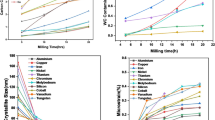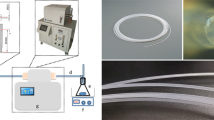Abstract
The feasibility of preparing ultrafine and nanometer-sized titanium carbide particles by self-propagating high-temperature synthesis (SHS) has been studied. Data are presented on the structure formation of TiC powders during SHS with a reduction step. Basic to this process is an exothermic reaction between titanium dioxide, magnesium metal, and carbon. The effects of the composition of the starting mixture, relationship between its components, and the morphology and particle size of the starting TiO2 powder on the particle size of the forming material have been investigated. The TiC powder was recovered from the sinter cake by chemical dispersion, a chemothermal treatment of the synthesis product in different solutions. The results demonstrate that treatment of the sinter cake with appropriate solutions removes impurities and causes imperfect intergranular layers to dissolve. As a result, the cake breaks down into homogeneous single-crystal particles. Subsequent treatment in different solutions further reduces the particle size of the powder. The effect of the composition of the dispersing solution on the particle size of the TiC powder has been studied. Our results made it possible to identify conditions for the preparation of titanium carbide powders containing up to 70% of particles less than 0.3 μm in size by SHS followed by chemical dispersion.
Similar content being viewed by others
References
Kosolapova, T.Ya., Karbidy (Carbides), Moscow: Metallurgiya, 1968.
Kosolapova, T.Ya. and Makarenko, G.N., Processes for the Preparation of Pure Carbides, in Tugoplavkie karbidy (Refractory Carbides), Kiev: Naukova Dumka, 1970, pp. 16–20.
Makarenko, G.N. and Miller, T.N., Plasma Synthesis of Refractory Carbides, in Karbidy i splavy na ikh osnove (Carbides and Related Alloys), Kiev: Naukova Dumka, 1976, pp. 5–9.
Kosolapova, T.Ya., Makarenko, G.N., and Zyatkevich, D.P., Plasma Synthesis of Refractory Compounds, Zh. Vses. Khim. O-va. im. D. I. Mendeleeva, 1979, vol. 24, no. 3, pp. 328–333.
Popov, V.E. and Gurin, V.N., Preparation of Crystalline Refractory Carbides from Solutions in Low-Melting-Point Metals, in Karbidy i splavy na ikh osnove (Carbides and Related Alloys), Kiev: Naukova Dumka, 1976, pp. 21–26.
Merzhanov, A.G., Fizicheskaya khimiya: sovremennye problemy (Current Issues in Physical Chemistry), Kolotyrkin, Ya.M., Ed., Moscow: Khimiya, 1983.
Merzhanov, A.G., Combustion: New Manifestation of an Ancient Process, Chemistry of Advanced Materials, Rao, C.N.R., Ed., Oxford: Blackwell, 1992, pp. 19–39.
Lagunov, Yu.V., Pikalov, S.N., Kolomoets, G.G., and Mamyan, S.S., Preparation of Boron Nitride by Enriching a Reduction Step SHS Product, Materialy 3-ei vsesoyuznoi konferentsii po tekhnologii goreniya (Proc. 3rd All-Union Conf. on Combustion Technologies), Chernogolovka, 1981, vol. 1, pp. 40–42.
Vershinnikov, V.I., Ignat’eva, T.I.,, Goziyan, A.V., et al., RF Patent 2 200 128, Byull. Izobret., 2000, no. 7.
Borovinskaya, I.P., Chemical Classes of the SHS Processes and Materials, Pure Appl. Chem., 1992, vol. 64, no. 7, pp. 919–940.
Borovinskaya, I.P., Ignat’eva, T.I., Vershinnikov, V.I., et al., Preparation of Ultrafine Boron Nitride Powders by Self-propagating High-Temperature Synthesis, Neorg. Mater., 2003, vol. 39, no. 6, pp. 698–704 [Inorg. Mater. (Engl. Transl.), vol. 39, no. 6, pp. 588–593].
Borovinskaya, I.P., Ignat’eva, T.I., Vershinnikov, V.I., and Sachkova, N.V., Preparation of Tungsten Carbide Nanopowders by Self-propagating High-Temperature Synthesis, Neorg. Mater., 2004, vol. 40, no. 10, pp. 1190–1196 [Inorg. Mater. (Engl. Transl.), vol. 40, no. 10, pp. 1043–1048].
El-Eskandarany, M.S. and Sherif, M., Synthesis of Nanocrystalline Titanium Carbide Alloy Powders by Mechanical Solid State Reaction, Metall. Mater. Trans. A, 1996, vol. 27, p. 2374.
LaSalvia, J.C., Meyer, L.W., and Meyers, M.A., Densification of Reaction-Synthesized Titanium Carbide by High-Velocity Forging, J. Am. Ceram. Soc., 1992, vol. 75, p. 592.
Cochepin, B., Heial, E.M., Vrel, D., and Dubois, S., Microstructural Study of TiC Formed during Initial Stages of Combustion Synthesis, Int. J. Self-Propag. High-Temp. Synth., 2004, vol. 13, no. 1.
Vasserman, A.M., Kunin, L.A., and Surovoi, Yu.N., Opredelenie gazov v metallakh (Gas Determination in Metals), Moscow: Nauka, 1976.
Remy, H., Lehrbuch der anorganische Chemie, Leipzig: Akademie, 1960. Translated under the title Kurs neorganicheskoi khimii, Moscow: Inostrannaya Literatura, 1963, vol. 1, p. 265.
Remy, H., Lehrbuch der anorganische Chemie, Leipzig: Akademie, 1960. Translated under the title Kurs neorganicheskoi khimii, Moscow: Inostrannaya Literatura, 1963, vol. 1, p. 507.
Spravochnik po elektrokhimii (Handbook of Electrochemistry), Sukhotin, A.M., Ed., Leningrad: Khimiya, 1981.
Avgustinik, A.I., Drozdetskaya, G.V., and Ordan’yan, S.S., Chemical Interaction between Titanium Carbide and Water, Poroshk. Metall. (Kiev), 1967, no. 6, pp. 53–57.
Kolenko, E.A., Tekhnologiya laboratornogo eksperimenta. Spravochnik (Experimental Tools in the Laboratory: A Handbook), St. Petersburg: Politekhnika, 1994.
Kugai, L.N., Kornilova, V.I., Nazarchuk, T.N., and Borovinskaya, I.P., Chemical Properties of Powders of Titanium Carbide in Its Homogeneity Range, Poroshk. Metall. (Kiev), 1980, no. 9, pp. 58–61.
Kuzenkova, M.A., Structure, Properties, and Applications of Powders of Refractory Compounds Prepared by Different Methods, Materialy vsesoyuznoi konferentsii po tekhnologii goreniya (Proc. All-Union Conf. on Combustion Technologies), Chernogolovka, 1987, vol. 2, pp. 47–50.
Andersson, Karin M. and Bergström, L., Oxidation and Dissolution of Tungsten Carbide Powder in Water, Int. J. Refract. Met. Hard Mater., 2000, vol. 18, nos. 2–3, pp. 121–129.
Author information
Authors and Affiliations
Corresponding author
Additional information
Original Russian Text © I.P. Borovinskaya, T.I. Ignat’eva, O.M. Emel’yanova, V.I. Vershinnikov, V.N. Semenova, 2007, published in Neorganicheskie Materialy, 2007, Vol. 43, No. 11, pp. 1343–1350.
Rights and permissions
About this article
Cite this article
Borovinskaya, I.P., Ignat’eva, T.I., Emel’yanova, O.M. et al. Self-propagating high-temperature synthesis of ultrafine and nanometer-sized TiC particles. Inorg Mater 43, 1206–1214 (2007). https://doi.org/10.1134/S002016850711009X
Received:
Issue Date:
DOI: https://doi.org/10.1134/S002016850711009X




